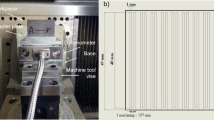Abstract
This paper is aimed to investigate the influence of material hardness on the behaviour of cutting edge radius in tool-based micromachining process. The main governing process parameter considered for this study is relative tool sharpness (RTS) which is quantified as the ratio of undeformed chip thickness (a) to tool edge radius (r). The variation of RTS influences the chip formation behaviour with transition from concentrated shearing to ‘extrusion-like’ mechanism for achieving ‘grinding-like’ surface finishing by the extensive tool edge radius effect. As different materials have different characteristics and properties, the critical threshold RTS value (RTS critical ) may vary with material hardness by significantly affecting the surface topography during ‘extrusion-like’ mechanism. In this study, material hardness is found to be an important mechanical property in orthogonal micro turning experiments conducted with a CBN tool for metal alloys. Best finishing (R a ) values of workpiece surfaces were used to determine the material hardness effect on RTS critical . Firstly, Aluminium and Magnesium alloys were used to construct a graphical trend for the relationship of material hardness and relative tool sharpness. Secondly, a random material was selected to predict the RTS value from the graphical trend based on material hardness. Thirdly, micro turning experiments were conducted to validate the predicted result. Finally, the graphical trend was updated to get the relationship of material hardness and critical relative tool sharpness (RTS critical ) with the three experimental materials which are most widely used in micromachining industries.
Similar content being viewed by others
References
Masuzawa T (2000) State of the art of micromachining. CIRP Ann Manuf Technol 49(2):473–488
Rahman M, Lim HS, Neo KS, Kumar AS, Wong YS, Li XP (2007) Tool-based nanofinishing and micromachining. J Mater Process Technol 185:2–16
Zhanqiang L, Zhenyu S, Yi W (2013) Definition and determination of the minimum uncut chip thickness of microcutting. Int J Adv Manuf Technol 69:1219–1232
Outeiro JC, Astakhov VP (2005) The role of the relative tool sharpness in modelling of the cutting process. Proc Eigth CIRP Int Workshop Model Mach Oper:517–524
Woon KS, Rahman M (2010) The effect of tool edge radius on the chip formation behaviour of tool-based micromachining. Int J Adv Manuf Technol 50:961–977
Kalpakjian S, Schmid SR (2006) Manufacturing, engineering & technology, 5th edn. Prentice Hall, USA
Fang FZ, Wu H, Zhou W, Hu XT (2007) A study on mechanism of nano-cutting single crystal silicon. J Mater Process Technol 184:407–410
Woon KS, Rahman M (2010) Extrusion-like chip formation mechanism and its role in suppressing void nucleation. CIRP Ann Manuf Technol 59:129–132
Singh V, Rao PV, Ghosh S (2012) Development of specific grinding energy model. Int J Mach Tools Manuf 60:1–13
Schimmel RJ, Endres WJ, Stevenson R (2002) Application of an internally consistent material model to determine the effect of tool edge geometry in orthogonal machining. J Manuf Sci Eng 124(3):536–543
Zhang X, Arif M, Liu K, Kumar AS, Rahman M (2013) A model to predict the critical undeformed chip thickness in vibration-assisted machining of brittle materials. Int J Mach Tools Manuf 69:57–66
Moriwaki T, Sugimura N, Luan S (1993) Combined stress, material flow and heat analysis of orthogonal micromachining of copper. CIRP Ann Manuf Technol 42(1):75–78
Yen YC, Jain A, Altan T (2004) A finite element analysis of orthogonal machining using different tool edge geometries. J Mater Process Technol 146(1):72–81
Mian AJ, Driver N, Mativenga PT (2010) A comparative study of material phase effects on micro-machinability of multiphase materials. Int J Adv Manuf Technol 50(1):163–173
Nasr MNA, Ng EG, Elbestawi MA (2007) Modelling the effects of tool-edge radius on residual stresses when orthogonal cutting. AISI 316 L. Int J Mach Tools Manuf 47:401–411
Author information
Authors and Affiliations
Corresponding author
Rights and permissions
About this article
Cite this article
Rahman, M.A., Amrun, M.R., Rahman, M. et al. Investigation of the critical cutting edge radius based on material hardness. Int J Adv Manuf Technol 88, 3295–3306 (2017). https://doi.org/10.1007/s00170-016-9031-4
Received:
Accepted:
Published:
Issue Date:
DOI: https://doi.org/10.1007/s00170-016-9031-4



